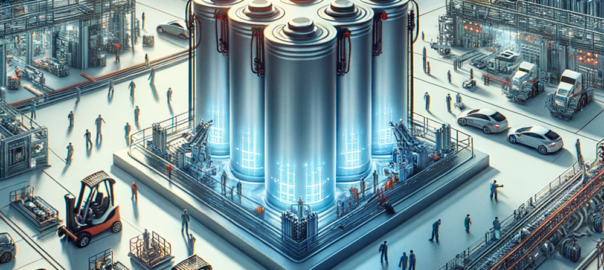As the world transitions towards a decarbonized energy future, batteries—the silent powerhouses of modern technology—have become ever more crucial. From our smartphones to electric vehicles and renewable energy storage, batteries underpin many aspects of modern life. Their development and evolution has continually broken barriers, allowing us to explore untapped potentials in various sectors. In this article, we will delve deep into the next generation of battery technologies, studying their potential, challenges, and prospective impacts on our future.
Contents
The Current State of Battery Technology
The current global market is dominated by lithium-ion batteries, largely due to their high energy density, light weight, and long cycle life. These batteries employ lithium ions moving from the negative electrode to the positive electrode during discharge, and back when charging. They are extensively used in portable electronics and electric vehicles, and are starting to be used for grid storage.
Despite their ubiquity and advantages, lithium-ion batteries also have notable drawbacks. They are prone to overheating and have associated safety concerns including fire risk. Moreover, the sourcing of lithium and cobalt (often used in the battery’s cathode) raises concerns about resource scarcity and ethical sourcing.
Table 1: Comparative Analysis of Battery Technologies
| Battery Type | Energy Density | Lifetime | Cost | Safety | Environmental Impact |
|---|---|---|---|---|---|
| Lead Acid | Low | Low | Low | High | High |
| Nickel Cadmium | Medium | High | Medium | Medium | High |
| Nickel-Metal Hydride | High | High | High | High | Medium |
| Lithium-Ion | Very High | Very High | High | Medium | Medium |

The Environmental Impact of Current Batteries
The environmental impact of batteries is often overlooked but represents a significant challenge. From mining the raw materials to disposal at the end of their life, batteries have several environmental and human health impacts.
The production process of lithium-ion batteries is energy-intensive and contributes to air pollution and climate change. Additionally, improper disposal of batteries can lead to harmful substances leaking into the environment, damaging soil and water quality and impacting biodiversity. According to the Global E-Waste Monitor, the world produced 53.6 million metric tons of electronic waste in 2019, and this figure is expected to double by 2050.
The Demand for Advanced Battery Technologies
In an increasingly electrified world, the demand for advanced and efficient battery technologies has never been greater. The key drivers are twofold: the renewable energy sector’s need for efficient energy storage solutions and the burgeoning electric vehicle market’s quest for improved performance and range.
Renewable energy sources like solar and wind are intermittent, necessitating energy storage solutions that can balance supply and demand. Advanced battery technologies could offer high capacity and efficient storage, smoothing out power delivery and making renewables more viable.
The electric vehicle (EV) market is another major driving force. Consumers demand EVs that can travel further on a single charge, charge faster, and have longer overall battery life. Meeting these demands requires significant advancements in battery technology.
Table 2: Projected Battery Demand by Industry (in GWh)
| Industry | 2023 | 2025 | 2030 | 2035 |
|---|---|---|---|---|
| Consumer Electronics | 400 | 450 | 550 | 600 |
| Electric Vehicles | 600 | 1500 | 5500 | 10000 |
| Grid Storage | 100 | 300 | 1500 | 3500 |

Next-Generation Battery Technologies
Many promising next-generation battery technologies are being developed to meet this surging demand. Let’s delve into a few notable ones.
Solid-State Batteries – These batteries replace the liquid or polymer electrolyte in conventional batteries with a solid. This can potentially enhance safety, energy density, and life-span.
Lithium-Sulfur Batteries – Lithium-sulfur batteries boast a higher theoretical energy density than lithium-ion batteries. They are lightweight and use sulfur, which is abundant and environmentally benign.
Lithium-Air Batteries – Also known as Li-air, these batteries could offer very high energy density. They have the potential to provide electric cars with a much greater range, but there are significant technical challenges to overcome.
Graphene Batteries – These batteries leverage graphene, a single layer of carbon atoms, in their electrodes. They promise faster charging times, increased energy storage, and longer lifetimes.
Table 3: Comparative Analysis of Next-Gen Battery Technologies
| Battery Type | Energy Density | Lifetime | Safety | Development Stage |
|---|---|---|---|---|
| Solid-State | Very High | Very High | High | Early Commercial |
| Lithium-Sulfur | Highest | High | Medium | Research & Development |
| Lithium-Air | Highest | Medium | Low | Research & Development |
| Graphene | Very High | Very High | High | Early Commercial |
Challenges and Potential Solutions
Despite their potential, next-generation battery technologies face significant challenges. These hurdles include technical issues related to efficiency, lifetime, and safety, as well as manufacturing scalability and cost-effectiveness.
Solid-state batteries, for example, are challenged by the development of suitable solid electrolytes, which need to be highly conductive, stable, and manufacturable on a large scale. For lithium-sulfur and lithium-air batteries, one key challenge is their relatively short cycle life due to rapid capacity fade.
Substantial research and development (R&D) efforts are underway to address these challenges. These include developing new materials and battery designs, improving manufacturing processes, and enhancing the understanding of battery performance and degradation mechanisms.

The Future of Battery Technologies
The future of battery technology is promising, albeit uncertain. It’s likely that different technologies will succeed in different applications based on their strengths and weaknesses.
Solid-state and graphene batteries could dominate the EV and portable electronics markets due to their high energy density and safety. Lithium-sulfur and lithium-air batteries, with their potential for very high energy density, could be game-changers if their technical challenges are overcome.
The continued development of these and other battery technologies is crucial for the transition to a more sustainable future. Advanced batteries could support the proliferation of renewable energy and electric vehicles, reduce e-waste, and open up new possibilities in sectors from aerospace to wearables.
The future could also see the convergence of battery technology with other fields. For example, the integration of batteries with flexible electronics could open up exciting possibilities in wearable technology.
These developments offer exciting opportunities but also pose challenges that will require significant efforts from scientists, engineers, policymakers, and industry leaders.
Conclusion
As we venture deeper into the 21st century, the race to develop and deploy advanced battery technologies continues to gain momentum. The burgeoning demand for efficient, high-capacity, and environmentally benign power storage systems is prompting researchers and industry leaders alike to overcome the formidable challenges that stand in the way of next-gen batteries. Despite these challenges, there’s an air of cautious optimism. The ongoing surge of research and development in this field holds promise that these hurdles will be surmounted in the coming years. In a world increasingly conscious of its environmental footprint, the future of batteries looks bright indeed. As we strive towards sustainability, the silent powerhouses of our technology—the batteries—will continue to play a pivotal role in shaping our future.










